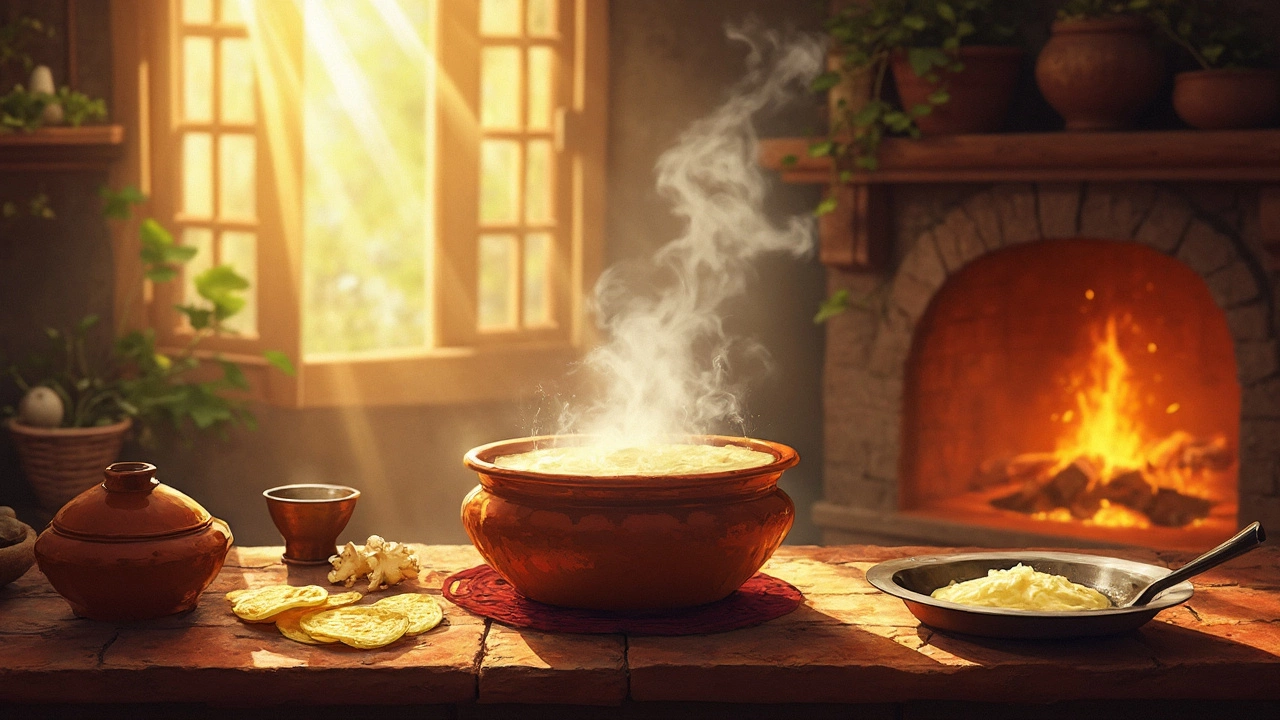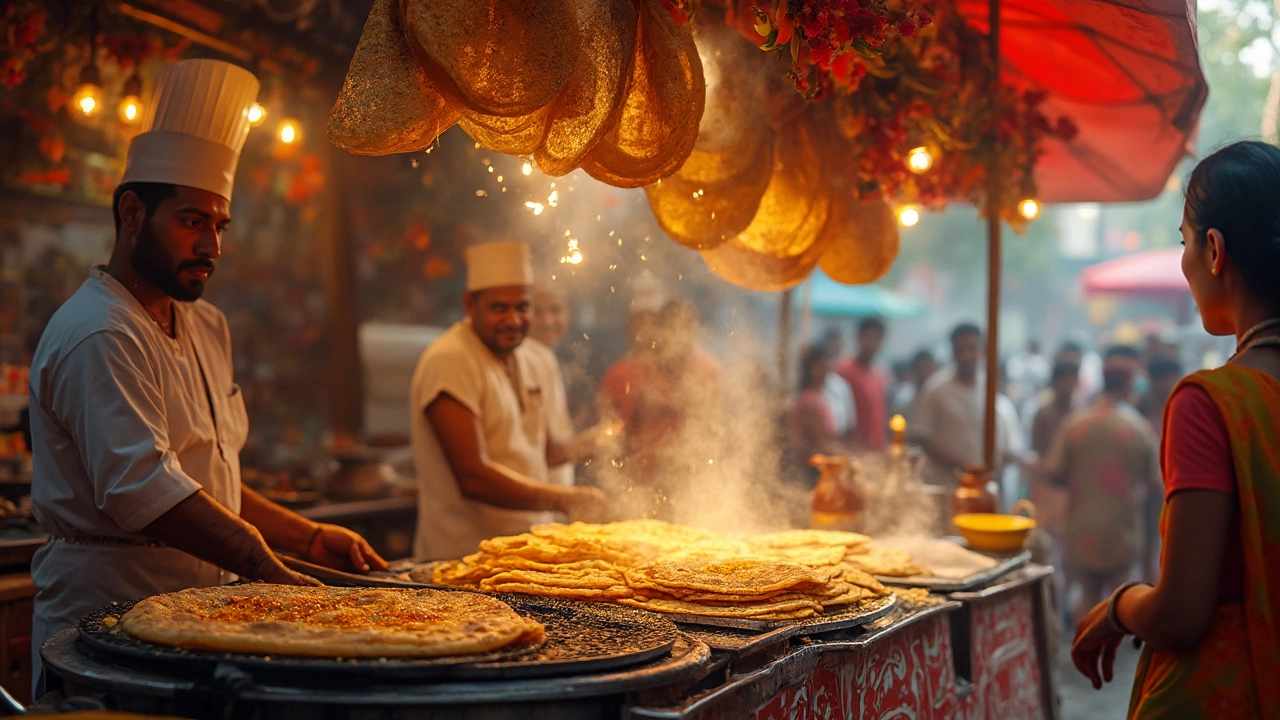Fast-Track Your Dosa Batter Fermentation
 Feb, 17 2025
Feb, 17 2025
Do you love dosas but hate the wait for the batter to ferment? We've all been there, ready for that crispy goodness, only to realize the batter's not quite ready. Fear not, because there are clever ways to speed up the process without compromising on taste.
The first trick is to know where to keep the batter. Temperature matters a lot! Find a warm spot in your kitchen. Above the fridge or inside the oven (with the light on) are great options since they offer a bit of cozy warmth, even in colder climates.
Adding a pinch of fenugreek seeds can work wonders too. These tiny seeds act like natural yeast and promote faster fermentation. Just toss a few into your batter mix for a quicker turnaround.
- Understanding Traditional Fermentation
- Kitchen Warm Spots
- Boosting with Ingredients
- Using Appliances Wisely
- Seasonal Adjustments
- Troubleshooting Common Issues
Understanding Traditional Fermentation
Fermenting dosa batter is a bit like magic—it turns a simple mix of rice and lentils into the delicious, crispy delight we all enjoy. But how does it actually work?
The secret lies in the natural bacteria and yeast present in the ingredients and the environment. When you mix rice and urad dal and leave them in a warm place, these microorganisms start to break down the starches, producing lactic acid and carbon dioxide. This process not only adds that signature tangy flavor but also makes the batter rise and become airy.
The Right Mix
For traditional dosa batter, use a 3:1 ratio of rice to urad dal. It’s important because this balance provides the perfect texture and flavor. Some folks add a bit of poha (flattened rice) or cooked rice to help soften the dosas.
Time and Temperature
Under normal circumstances, it takes about 8-12 hours for dosa batter to ferment properly, depending on the ambient temperature. Warmer temperatures speed up fermentation, which is why this process happens a lot quicker in places with hot climates.
The Science Behind It
Curious about the ideal fermentation temperature? It's between 30-32°C (86-90°F). This range ensures the beneficial bacteria thrive without letting the batter spoil.
Remember, if the batter doesn't ferment well, it might be because the temperature's been too low or the batter was too thick. Adding a splash of water can help thin it out and enhance the process.
Importance of Freshness
Always use fresh ingredients. Old rice or lentils might not have the same microbial activity, leading to poor fermentation. Freshness can be the difference between a light, fluffy dosa and a dense, pancake-like one.
By understanding these traditional fermentation basics, you'll appreciate the process and might even get excited about experimenting with it. Who wouldn't want to shave a few hours off the wait for a batch of dosa batter that's ready to make those perfect dosas?
Kitchen Warm Spots
Finding that ideal spot in your kitchen can be a game-changer for fermenting dosa batter quickly. The whole idea is to give the batter a consistently warm environment, just like it would have in tropical climates.
Above Your Fridge
The top of your fridge might seem like an odd place, but it's actually perfect. The heat generated by the fridge creates a naturally warm area, making it an awesome choice for helping your dosa batter ferment faster.
Inside the Oven
If you've never thought to use your oven for more than baking, you're in for a treat. Just place the batter inside with the oven light turned on. The light generates enough warmth to give the batter a cozy spot. Just don't turn the oven on by accident!
Near a Window
Another clever spot is somewhere near a sunny window during the day. The natural sunlight adds warmth, especially during the cooler months. Make sure it's just the right amount of sun, though; you don't want to cook the batter!
Using a Thermos
Although it might sound unconventional, using a large thermos to keep the batter warm is smart. Fill the thermos with hot water for a few minutes to heat it up, dump the water, and then add your batter. The warmth stays longer, which helps fermentation.
Here's a quick comparison of some ideal spots for fermenting:
| Location | Temperature Range (°C) |
|---|---|
| Top of Fridge | 24-28 |
| Oven with Light On | 30-32 |
| Sunny Window | 22-26 |
Remember, the goal is to keep the batter warm but not hot. Keeping the batter at these temperatures speeds up the process while maintaining the batter's quality. Once you nail the right spot, you're well on your way to making perfect crispy dosas more quickly!
Boosting with Ingredients
Did you know that adding specific ingredients can speed up the fermentation process of your dosa batter? But what works and how?
Using Fenugreek Seeds
Fenugreek seeds, or 'methi' as we call them in India, pack a punch when it comes to enzyme activity. A small dose of about a teaspoon can significantly amp up the fermentation, thanks to their natural yeast-boosting capabilities. Just soak them with your rice and dal before grinding and watch the magic unfold.
Add a Little Yogurt
Incorporating a few tablespoons of yogurt or buttermilk into your batter can work wonders. These dairy marvels are already fermented, carrying live cultures that catalyze the process, cutting that usual wait time in half. Plus, they add a delightful tang to your dosas.
Sugar: A Sweet Accelerator
Believe it or not, a pinch of sugar can help too. Yeast loves sugar, just like a kid loves candy! When you mix sugar into the batter, it feeds the yeast and speeds up fermentation. Don't worry, it won't make your dosa recipe sweet at all.
| Ingredient | Impact on Fermentation | Amount |
|---|---|---|
| Fenugreek Seeds | Boosts natural yeast activity | 1 tsp |
| Yogurt | Introduces live cultures | 2-3 tbsp |
| Sugar | Feeds yeast | A pinch |
These simple kitchen hacks not only cut your wait time but also ensure that your dosa turns out crispy and perfect every time. Give them a try and see your batter bubble up faster than ever before.

Using Appliances Wisely
Our kitchens are packed with gadgets that can do more than just their usual jobs. If you're looking to fast-track your dosa batter fermentation, think about leveraging some of these appliances.
The Power of the Oven Light
One of the simplest tricks is to use your oven as a makeshift fermenter. Keep the oven light on; it generates just enough heat to keep the environment warm, which is perfect for speeding up the fermentation process. Just make sure the oven is off—nobody wants baked batter!
Instant Pot Magic
If you own an Instant Pot, you're in luck! This appliance has a 'Yogurt' setting that's ideal for fermenting dosa batter. Simply set it to 'Yogurt' for 8-10 hours, and you'll notice the batter bubbling up and ready much quicker than usual.
Microwave Hack
No Instant Pot? No worries! You can use your microwave too. Just heat a cup of water in the microwave for about 2 minutes. Then, place the dosa batter container inside while the microwave is off. The warmth and moisture from the water help in kick-starting the fermentation.
Electric Heater in Colder Months
In colder weather, an electric heater can become your friend. Place the batter close to a safe heater, gently warming up the surroundings. This can shave hours off the waiting time and have your crispy dosas ready in no time.
Time Comparisons
| Method | Average Time to Ferment |
|---|---|
| Traditional Room Temp | 12-14 hours |
| Oven with Light | 8-10 hours |
| Instant Pot | 8-10 hours |
By using your appliances wisely, you not only save time but also ensure that the dosa batter gets the cozy environment it needs to ferment perfectly. Give these tricks a shot, and you might just change your dosa-making game forever!
Seasonal Adjustments
Weather changes aren't just about swapping your wardrobe; they can affect your dosa batter fermentation too. Different seasons bring variations in temperature and humidity, which can either speed up or slow down the process. Learning how to tweak your technique based on the season can make all the difference.
Summer Strategies
In the hot and humid days of summer, nature is on your side. Fermentation usually happens faster in warm weather. To prevent the batter from souring too quickly, consider reducing the soaking and grinding time of your rice and urad dal slightly. You want it just right without it getting too acidic.
- Use cooler water when grinding, as the kitchen is already warm enough to auto-start fermentation.
- Ferment the batter in a cooler, less direct area to avoid over-fermentation.
Winter Wins
When those chilly days hit, the dosa batter takes its own sweet time. But you can outsmart the cold with a few tricks. Keep the batter near a warm appliance or preheat your oven to the lowest setting, then turn it off, and let the batter chill inside.
- Increase the soaking time or slightly warm the water to kickstart the fermentation.
- If it's super cold, a spoon of yogurt mixed in the batter can help.
- Consider using a thin cotton cloth to cover the batter container to retain warmth.
Monsoon Moves
During the rainy season, humidity is the real problem. Your batter can stay too wet, which hampers proper fermenting. Consider cutting back on the water when grinding.
- If the batter feels runny post-fermentation, add a bit of rice flour to balance the consistency.
- You may need an extra hour or two of fermentation than usual.
Adjustments like these can help your dosa recipe align with the season, so you never have to wait long for a delicious breakfast.
Troubleshooting Common Issues
Fermenting dosa batter can sometimes be tricky, and you might run into issues that slow you down. Knowing how to troubleshoot these common problems can save you time and frustration.
Problem 1: Batter Not Fermenting
If your batter hasn't budged overnight, check the temperature. Fermentation loves warmth. If it's too cold, place the batter in a warmer setting, like near a window during daylight or in an oven with the light on.
An added boost can come from using a teaspoon of sugar. This sweet addition can kickstart the process by feeding the natural yeast in the environment.
Problem 2: Batter Turns Sour
Getting overly sour batter? It might be fermenting too fast or for too long. Try using less soaked rice and dal next time, or shorten the fermentation time by a few hours.
If you find it too sour, mix in some fresh batter into the fermented one. It balances out the taste without wasting anything.
Problem 3: Batter Consistency Problems
A thick or thin batter can mess up your dosa recipe. If it's too thick, adding a splash of water before cooking can improve spreadability. For batter that's too thin, add a bit of rice flour to reach your desired consistency.
- For proper thickness, remember: the batter should coat a spoon but pour off without being too runny.
Problem 4: Dosa Sticking to Pan
Sticking can be a result of a pan that's either too hot or too cold. Preheat your tawa well before pouring the batter. You can sprinkle water to check it; it should sizzle and evaporate immediately.
Using a non-stick or a well-seasoned iron tawa can also help. And ensure you're using the right amount of oil or ghee to prevent sticking.
When you nail these common issues, your dosa game will be as smooth as the batter you perfect. These solutions are simple tweaks but make all the difference!